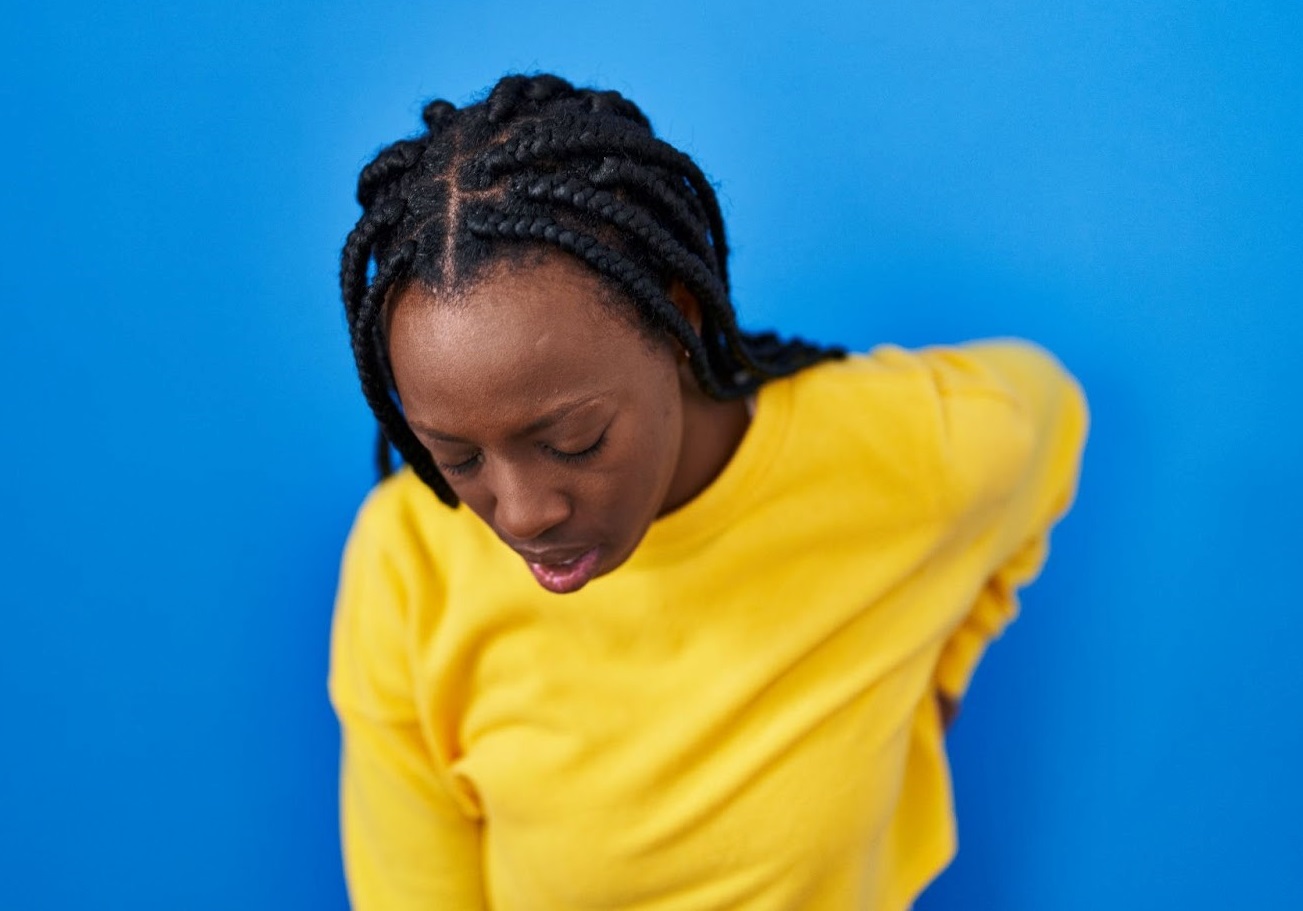By: Dr Temitope Oyetunji, MBBS, FWACP (Family Medicine). Medically reviewed by: Dr. Azuka Ezeike, MBBS, FWACS (Obstetrics and Gynaecology), FMCOG, MSc (Public Health).

A standing and distresed looking African female holding on her left lower back due to period pain. Designed by Freepik
Period pain (dysmenorrhoea) describes the pain women experience during menstruation. It is the most common reproductive health problem among women of reproductive age group, affecting up to 60-73% of women globally. [1]
Period pain is not just a physical condition; it also has social and economic impact, especially in Africa, where access to healthcare, education, and menstrual products may be limited.
Interestingly, cultural beliefs and the stigma around menstruation often prevent open discussions around this topic, leaving women to suffer in silence without proper care or support.
This article aims to educate on the types of dysmenorrhoea, its causes, and symptoms, and explore its profound impact on African females. It also highlights the unique challenges associated with period pain in the region.
What Are the Types of Period Pain?
Period pain can be grouped into two types:
Primary Period Pain or Dysmenorrhoea: This is the most common form of period pain experienced by many young girls and older women of reproductive age. It manifests as cramping pain in the lower abdomen and is not due to any underlying pelvic disease or medical condiition.
It typically starts just before or at the onset of menstruation and can last for up to 3 days. It is common in younger females. [2, 3]
Secondary Period Pain or Dysmenorrhoea: Unlike primary period pain, secondary period pain is usually due to an underlying pelvic abnormality or medical condition.
These conditions include endometriosis, adenomyosis, fibroids or pelvic inflammatory disease.
Pain often starts earlier in the menstrual cycle and may last longer than primary dysmenorrhoea. Secondary dysmenorrhoea is more common in older women (aged 35 years and above) and often requires medical or surgical intervention. [2]
The causes of period pain depend on whether the pain is categorized as primary or secondary.
Primary Cause of Period Pain: The primary cause of period pain is the release of high levels of a special chemical called prostaglandins from the inner lining of the womb (uterus). This is a natural process that follows ovulation (release of egg) in females.
Prostaglandins cause the muscles and vessels of the womb to contract and relax. Prostaglandins can also directly or indirectly trigger pain by affecting the nerves that sense pain and those connected to the womb. These combined actions explain the pain or period cramps that women associate with menstruation.
The release of prostaglandins also causes other symptoms associated with period pain such as diarrhoea, which some people call “period poop”.
The more the prostaglandin levels, the more the intensity of the uterine contractions and pain that women experience. [2, 3]
Secondary Causes of Period Pain, on the other hand, is linked to underlying medical conditions. [2, 4]
These include:
Endometriosis: A condition where tissue similar to the uterine lining grows outside the uterus, causing severe pain and inflammation.
Fibroids: These are non-cancerous growths in the uterus prevalent in African females. They can cause heavy bleeding and painful periods.
Pelvic inflammatory disease (PID): An infection of the female reproductive organs that may lead to chronic pelvic pain.
Adenomyosis: A condition where the uterine lining grows into the muscle wall of the uterus, causing heavy and painful periods.
Other structural anomalies, ovarian cysts and intrauterine devices (usedas birth control) can also contribute to menstrual pain in some cases.
Several risk factors have been associated with period pain. [2, 4]
They include:
The symptoms of period pain can vary widely between individuals, depending on its type and severity.
Primary dysmenorrhoea or period pain, typically presents with cramping pain in the lower abdomen that may spread to the lower back and thighs. Pain is usually spasmodic (i.e., occurs in waves) and can range from mild to severe.
Primary dysmenorrhoea can also present with other symptoms. [2, 3] that include:
The symptoms of secondary dysmenorrhoea or period pain may be equally or more severe and more persistent than those of primary dysmenorrhoea. [2]
They can include:
For some women, the pain experienced during menses may be a mild inconvenience while for others, quality of life is significantly affected.
Several studies have identified some of these effects of menstruation on women’s daily life, education and work. [1, 5-7]
They include:
The diagnosis of primary period pain or dysmenorrhoea is made based on medical history, physical examination and investigations as your doctor orgynaecologist considers necessary.
In taking your history, questions your doctor may ask include:
If secondary causes of period pain (secondary dysmenorrhoea) are suspected, your doctor would likely carry out abdominal and pelvic examination as well as further investigations/tests.
Some of these investigations include:
The goal of treatment of period pain is to provide adequate pain relief, improve quality of life, and reduce the burden of menstrual pain.
Treatment of period pain in African females involves a combination of:
Although research on the effectiveness of herbal remedies are limited and inconclusive, some women use these remedies with unsubstantiated positive results.
Medications used include nonsteroidal anti-inflammatory pain relievers that can be bought over-the-counter like ibuprofen and naproxen. Others include hormonal contraceptives and smooth muscle relaxants (antispasmodics) like Buscopan.
Although period pain is very common among women, many people are still unaware of its causes and when to seek medical advice. The idea that period pain is normal prevents many women from seeking medical treatment. [6]
However, if your period pain persists for more than 3 - 4 days after the use of over-the-counter medications, you should seek medical evaluation.
This is because accurately evaluating period pain is vital to determine whether it is primary or secondary dysmenorrhoea, and to identify any underlying conditions requiring treatment.
If you experience heavy menstrual bleeding associated with pain or more severe pain than usual, you should also seek medical advice.
When period pain, particularly that linked with secondary causes is left untreated, certain complications can occur. These include chronic pelvic pain, reduced fertility, and anaemia. [2]
Emotional and psychological complications like anxiety, depression, social isolation, and loss of productivity can also occur.

An African girl at a gathering, excited and smiling, surrounded by other African girls and women. Photo by Unsplash
The World Health Organization in a statement on menstrual health and rights recommend that people have access to information and education about menstruation and menstrual products. The body also recommended competent and empathic care and an environment where menstruation is seen as positive and healthy.
In the African context, some women, especially those in rural settings, still lack access to menstrual products and believe several myths about menstruation.
In a study in Uganda, authors reported anecdotal evidence that school matrons made students believe that dysmenorrhoea should be tolerated because labour pain is worse. In effect encouraging students to see period pain as necessary practice for labour pain. [6]
Another study in Tanzania which interviewed female students found that some of them believed medications used in treating dysmenorrhoea were harmful as they could cause undesirable changes in menstrual patterns or lead to infertility. [8]
These negative cultural beliefs often lead to delayed diagnosis as many women endure period pain for years without seeking care, leading to worsening complications.
Period pain is a significant yet often overlooked health issue that affects millions of girls and older women in Africa. While primary period pain or dysmenorrhoea is more common in younger females and easily treatable with self-care and medications, secondary period pain or dysmenorrhoea requires further evaluation and more comprehensive treatments. Tackling period pain goes beyond addressing physical symptoms. It requires improving healthcare access, combating social stigma and misinformation about period pain, and empowering women through education and advocacy. Women deserve the support needed to take control of their health and reclaim the productive days lost to period pain.
1. Belayneh W, Kassaye Z, Arusi T, Abera N, Hantalo A, Melkamu B, et al. Prevalence of dysmenorrhoea and associated factors and its effect on daily academic activities among female undergraduate students of Hawassa University College of Medicine and Health Sciences, Hawassa, Ethiopia. Front Reprod Health [Internet]. 2023 Dec 15 [cited 2024 Dec 22];5. Available from here.:
2. Nagy H, Carlson K, Khan MA. Dysmenorrhoea. In: StatPearls [Internet]. Treasure Island (FL): StatPearls Publishing; 2024. Last reviewed, Nov. 12, 2023. [Cited 2024 Dec 22]. Available from here.
3. Itani R, Soubra L, Karout S, Rahme D, Karout L, Khojah HMJ. Primary dysmenorrhoea: pathophysiology, diagnosis, and treatment updates. Korean J Fam Med.. 2022 Mar;43(2):101–8. doi: 10.4082/kjfm.21.0103. Available from here.
4. Nyirenda T, Nyagumbo E, Murewanhema G, Mukonowenzou N, Kagodora SB, Mapfumo C, et al. Prevalence of dysmenorrhoea and associated risk factors among university students in Zimbabwe. Womens Health (Lond Engl). 2023 Jan;19:17455057231189549. doi:10.1177/17455057231189549. Available from here.
5. Esan DT, Ariyo SA, Akinlolu EF, Akingbade O, Olabisi OI, Olawade DB, et al. Prevalence of dysmenorrhoea and its effect on the quality of life of female undergraduate students in Nigeria. Journal of Endometriosis and Uterine Disorders. 2024 Mar 1;5:100059. doi: 10.1016/j.jeud.2024.100059.Available from here.
6. Nakame RM, Kiwanuka F, Robert A. Dysmenorrhoea among students aged 18–45 years attending University in Uganda: A cross?sectional multicenter study of three Universities in Uganda. Nurs Open. 2018 Sep 27;6(2):268–75. doi: 10.1002/nop2.207. Available from here.
7. Mesele TT, Ayalew HG, Syoum AT, Antehneh TA. Impact of dysmenorrhoea on academic performance among Haramaya university undergraduate regular students, eastern Ethiopia. Front Reprod Health. 2022 Jul 6;4. doi: 10.3389/frph.2022.939035. Available from here.
8. Cherenack EM, Rubli J, Melara A, Ezaldein N, King A, Alcaide ML, et al. Adolescent girls’ descriptions of dysmenorrhoea and barriers to dysmenorrhoea management in Moshi, Tanzania: A qualitative study. PLOS Glob Public Health. 2023 Jul 6;3(7):e0001544. doi: 10.1371/journal.pgph.0001544.Available from here.
Related:
Published: December 29 2024
© 2024. Datelinehealth Africa Inc. All rights reserved.
Permission is given to copy, use and share content for non-commercial purposes without alteration or modification and subject to source attribution.
DATELINEHEALTH AFRICA INC., is a digital publisher for informational and educational purposes and does not offer personal medical care and advice. If you have a medical problem needing routine or emergency attention, call your doctor or local emergency services immediately, or visit the nearest emergency room or the nearest hospital. You should consult your professional healthcare provider before starting any nutrition, diet, exercise, fitness, medical or wellness program mentioned or referenced in the DatelinehealthAfrica website. Click here for more disclaimer notice.